GetInTouch Pin Research Project
Fostering meaningful interactions between strangers
Learn more

Team Members
Khoshnaz Kazemian, Christian J. Spengler
Tools Used
Fusion 360, Figma, MAXQDA
Duration
May 2024 to September 2024
University
Siegen University
______
Project Context
The GetInTouch Pin project was developed to address the growing issue of loneliness in today’s society, where face-to-face interactions are becoming rarer. This project envisions a future where wearable technology plays a key role in enhancing well-being by encouraging spontaneous interactions. The GetInTouch Pin is a small, smart device that glows green when the wearer is open to conversation, signaling to those nearby a willingness to connect. By facilitating interactions in everyday spaces like parks, cafes, and public transport, the pin aims to foster a sense of belonging, reduce social barriers, and ultimately improve mental well-being.
______
Reseach Questions
The research questions that guided our project were:
- What are the potential benefits and drawbacks of using such technology to encourage social engagement?
- How might this device impact users’ feelings of loneliness, and what ethical considerations arise?
- What social, cultural, or practical barriers might prevent the adoption of the GetInTouch Pin?
______
Problem Discovery
The project’s primary challenge was understanding and addressing the complex dynamics of loneliness and social isolation. With modern lifestyles increasingly relying on technology for communication, face-to-face interactions have declined, leaving many individuals, especially in urban settings, feeling isolated. Research showed that social isolation can have a significant negative impact on mental and physical well-being. The GetInTouch Pin project aimed to explore whether a simple, non-verbal cue, facilitated through technology, could help people feel more open to social engagement and reduce feelings of loneliness.
Key problems identified included:
- Barriers to Spontaneous Interaction: Social conventions and personal reservations often discourage people from initiating conversations with strangers, even when open to interaction.
- Need for Privacy and Consent: Many people are hesitant about wearables or devices that could inadvertently infringe on personal boundaries.
- Loneliness and Health Implications: Chronic loneliness has been linked to various health issues, reinforcing the importance of finding innovative solutions to address this societal problem.
______
Our Approach
The Research Through Design (RtD) approach, coupled with Design Fiction, was employed to explore the potential societal impact of the GetInTouch Pin. This methodology allowed the project team to create speculative scenarios around the pin and evaluate how such a device might be received in a future society where technology supports spontaneous social engagement.
______
Project Goals
The project sought to explore how technology can create new forms of social engagement and combat isolation. Specific goals included:
- Encouraging Spontaneous Interactions: Design a device that subtly signals the user’s openness to conversation, making it easier for people to engage with others in public spaces.
- Enhancing Well-Being: Investigate the potential psychological benefits of spontaneous social interactions facilitated by the device, particularly for those who may experience loneliness.
- Creating a Fictional Ecosystem: Use speculative design to explore the concept of a wearable device in a future where technology actively supports social well-being.
- Stimulating Reflection and Dialogue: Spark discussions around the societal implications, ethical considerations, and feasibility of using technology to mediate human connections.
______
Our Process
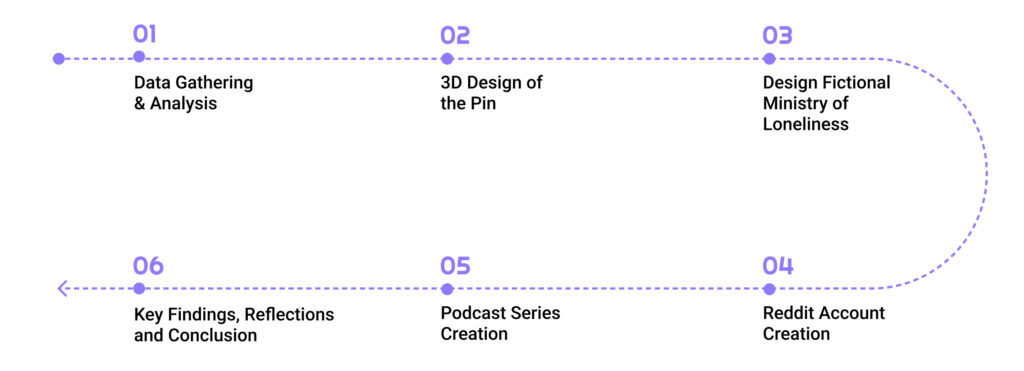
Step 01
Data Gathering & Analysis
______
Interviews
Five qualitative interviews were conducted to gather insights into participants’ views on the GetInTouch Pin concept. The participants, recruited through convenience sampling, included 2 females and 3 males with an average age of 34.2 years. Each interview lasted approximately 47 minutes, and methods such as ‘Futuristic Autobiographies’ and ‘Anticipatory Ethnography’ were employed to immerse participants in a future world where the GetInTouch Pin was a commonplace device.
Part of Interview Questions:
Participant Background
- What is your primary mode of transportation?
- Are you involved in any community organizations or activities?
- What activities do you enjoy in your free time? (e.g., reading, attending parties, outdoor adventures)
Introversion/Extraversion
- How comfortable are you with initiating conversations with strangers?
- Do you often initiate conversations with strangers, or do you wait for them to approach you?
- Do you find it easy or challenging to keep conversations going?
- How easy is it for you to form new friendships?
Imagined Experiences with the GetInTouch Pin
- Imagine you were using the GetInTouch pin regularly for a half a year. How has it changed your social life and interactions with others?
- How did the GetInTouch pin affect your sense of approachability? Did it make you feel more open and welcoming?
- Did using the GetInTouch pin affect your feelings of loneliness or connectedness? In what ways?
- Can you describe a new friendship or connection that developed because of the GetInTouch pin? How and where did it start, and how has it evolved?
- Has the use of the GetInTouch pin changed any of your social habits or routines? How so?
- Were there any unexpected outcomes from using the GetInTouch pin that you didn’t anticipate?
- What potential risks or dangers do you think could arise from wearing the GetInTouch pin? How might these impact your willingness to use it?
______
Thematic Analysis
The interview data was analyzed using thematic analysis to identify key themes related to the device’s perceived benefits, challenges, and potential implications. Themes included user expectations, possible social benefits, ethical concerns, and barriers to adoption, offering a detailed view of how such a device might influence social behavior and loneliness.
Here are the main identified themes:
- Facilitating Conversations and Social Interactions
- Social Confidence in Interactions
- Fostering Social Connection and Community
- Conversation Starters and Dynamics
- Facilitating initial interactions
- Social Signalling and Perception
- User Evolution and Personal Growth, Challenges and Implications
- Cultural Dynamics and Social Navigation in Travel
- Usage Contexts
- New Features from Participants
- First Impressions
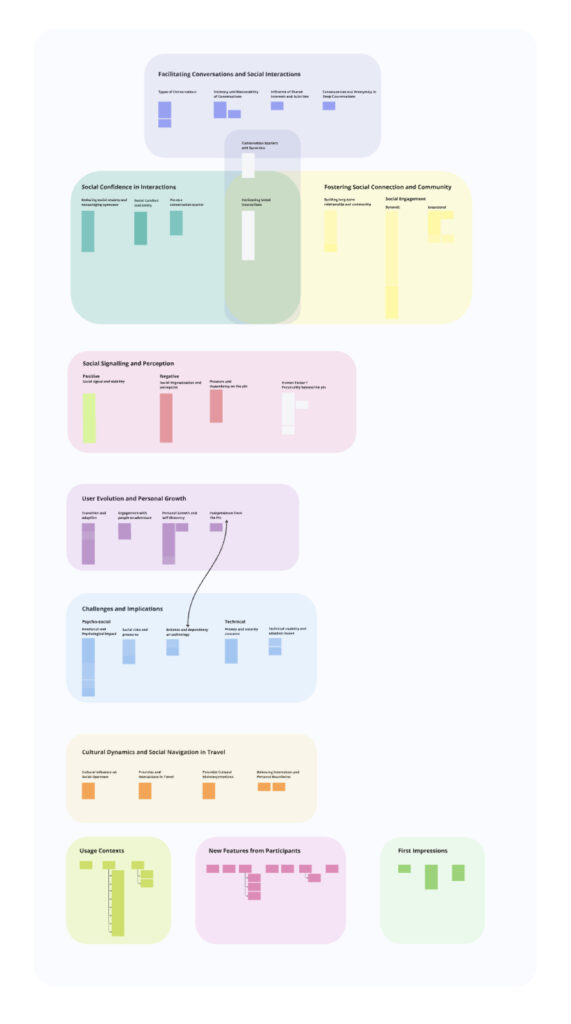
Step 02
Design Process
______
3D Design of the Pin
To visualize the product, a 3D model of the GetInTouch Pin was created. The design emphasized subtlety, portability, and ease of use, ensuring that the pin could be comfortably worn without drawing excessive attention. This model provided a tangible representation of the concept, making it easier for participants to relate to the idea.

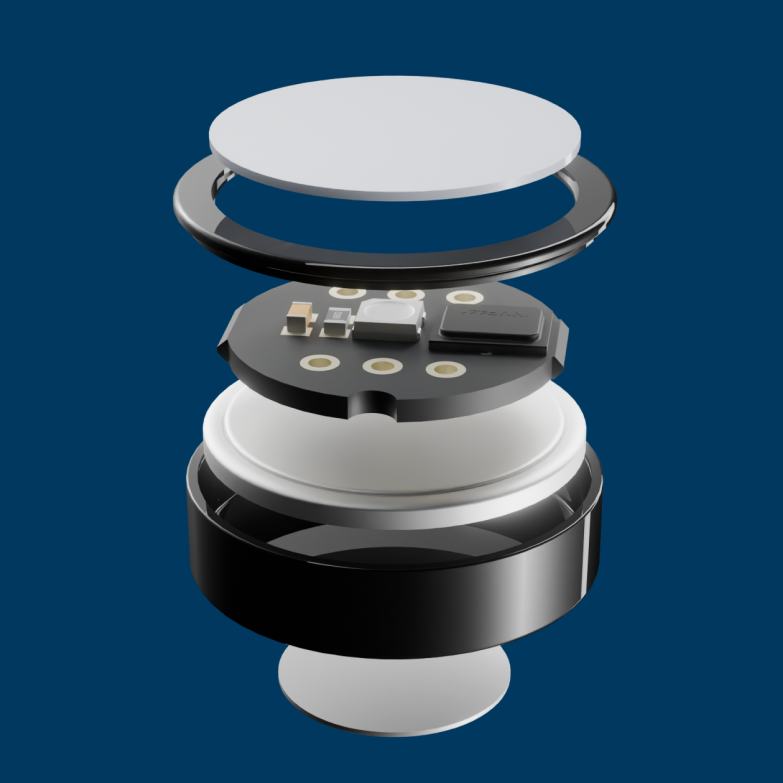
______
World “Refinement” and Speculative Context
Design Fictional Homepage for the Ministry of Loneliness
Initially, the team developed a homepage for the fictional German “Ministry of Loneliness” as a foundation for focus group discussions. However, this approach was adapted for Reddit, retaining the Ministry of Loneliness as the conceptual originator of the GetInTouch Pin project. The ministry context was intended to give the project a sense of legitimacy and relevance within the fictional world.
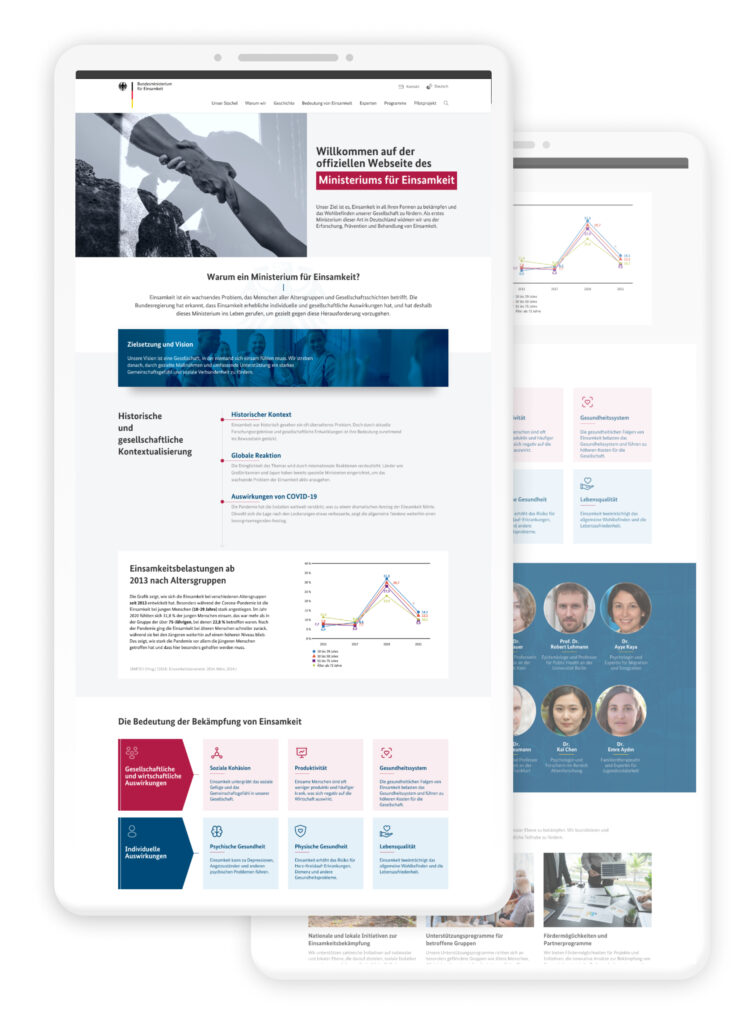
Reddit Account Creation
A fictional subreddit was created to engage participants in a believable online setting. The subreddit included a project logo, multiple posts, and comments, all crafted based on the interview data. Personas representing various perspectives on the pin concept were used to populate the subreddit, making it appear active and relatable. This speculative online community allowed participants to observe and engage in discussions around the pin in an organic way, mirroring real-life social media interactions.
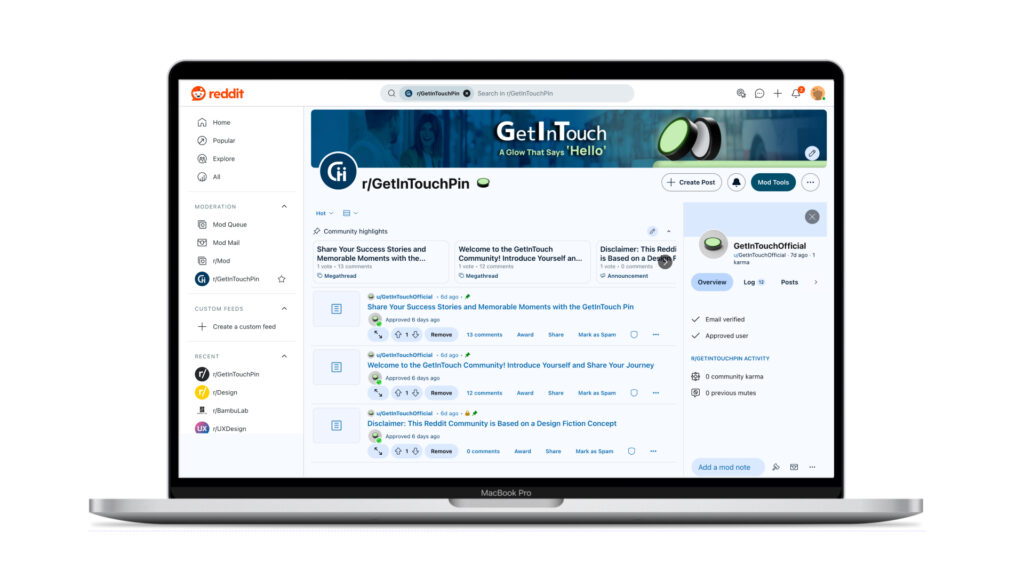
Podcast Series
Two fictional podcast episodes were produced, featuring perspectives from a “Minister of Loneliness” and the project’s lead researcher. These podcasts were posted in the subreddit, offering listeners a deeper narrative into the speculative world of the GetInTouch Pin. This added another layer to the fictional scenario, allowing participants to immerse themselves in the context and reflect on the implications of the device.

Episode 01
Federal Minister
Two fictional podcast episodes were produced, featuring perspectives from a “Minister of Loneliness” and the project’s lead researcher. These podcasts were posted in the subreddit, offering listeners a deeper narrative into the speculative world of the GetInTouch Pin. This added another layer to the fictional scenario, allowing participants to immerse themselves in the context and reflect on the implications of the device.

Episode 02
Head Researcher
In our second episode, we speak with Professor Marc Hassenzahl, the lead researcher of the GetInTouch project. He shares insights into the development of the pin, and fascinating results from the project’s pilot studies. We also explore the broader implications of using technology to mediate human connection, and the balance between fostering togetherness and preserving autonomy.
Results
______
Key Findings
Here are the important insights into how participants perceived and responded to the GetInTouch Pin within the speculative framework provided:
- Positive Reception: Participants generally reacted positively, seeing the pin as a potential tool to help reduce loneliness and encourage spontaneous connections in everyday life.
- Privacy Concerns: Some participants voiced concerns about privacy, noting that a wearable signaling openness to interaction could feel invasive and might pressure them to engage even when they didn’t wish to.
- Ethical Implications: Ethical questions emerged around the role of technology in mediating human interactions, particularly whether such a device might commercialize or trivialize social engagement.
- Adoption Barriers: Participants expressed doubts about the device’s viability without widespread societal adoption, as its success would largely depend on a cultural shift toward accepting technology as a facilitator of social interaction.
______
Design Improvements
Based on the insights, the team proposed several key improvements:
- Privacy and Control: Adding adjustable privacy settings to the pin, allowing users to control when and where it signals openness to interaction, would help users feel more comfortable and in control.
- Guidelines for Use: Providing guidance on etiquette and usage could help users and the public understand the device’s purpose, reducing the likelihood of social pressure and misunderstanding.
- Alternative Sensory Feedback: Non-visual feedback mechanisms, such as gentle vibrations, could help users feel more connected without drawing attention or causing discomfort.
- Additional Activation Options: Integrating a mobile app with the pin could allow for more personalized settings and give users options for how they engage in different social contexts.
______
Reflections on Design Fiction as a Methodology
Using design fiction allowed the team to explore a speculative concept that would otherwise be difficult to prototype and test traditionally. By framing the pin within a fictionalized world—including a Ministry of Loneliness, a subreddit, and podcasts—the project successfully prompted participants to consider the societal implications of the device. However, the speculative approach also posed challenges, especially in ensuring participants fully immersed themselves in the fictional world and responded authentically to the scenarios.
______
Conclusion and Future Directions
The GetInTouch Pin project demonstrated that wearable technology could play a role in reducing loneliness by encouraging spontaneous interactions. While participants were generally optimistic about the device’s potential, concerns around privacy, social pressure, and ethical implications highlighted areas that would need to be addressed for real-world implementation. Future directions for the GetInTouch Pin include exploring further customization options, examining real-world application possibilities, and continuing to balance technological innovation with respect for personal autonomy and authentic human connection.

